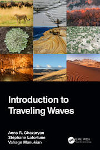- About MAA
- Membership
- MAA Publications
- Periodicals
- Blogs
- MAA Book Series
- MAA Press (an imprint of the AMS)
- MAA Notes
- MAA Reviews
- Mathematical Communication
- Information for Libraries
- Author Resources
- Advertise with MAA
- Meetings
- Competitions
- Programs
- Communities
- MAA Sections
- SIGMAA
- MAA Connect
- Students
- MAA Awards
- Awards Booklets
- Writing Awards
- Teaching Awards
- Service Awards
- Research Awards
- Lecture Awards
- Putnam Competition Individual and Team Winners
- D. E. Shaw Group AMC 8 Awards & Certificates
- Maryam Mirzakhani AMC 10 A Awards & Certificates
- Two Sigma AMC 10 B Awards & Certificates
- Jane Street AMC 12 A Awards & Certificates
- Akamai AMC 12 B Awards & Certificates
- High School Teachers
- News
You are here
Introduction to Traveling Waves

Publisher:
Chapman and Hall/CRC
Publication Date:
2022
Number of Pages:
174
Format:
Hardcover
Price:
96.00
ISBN:
978-0367707057
Category:
Textbook
[Reviewed by , on ]
Bill Satzer
07/22/2023
The authors wrote this book to provide students with enough background to study traveling waves and simultaneously enable them to develop some research experience of their own in that area. They had found that very little published material on traveling waves was accessible to students at the undergraduate and masters level. Accordingly, they prepared a book that requires only multivariable calculus, linear algebra, and basic differential equations. The authors also assume that readers are familiar with basic concepts of phase space and equilibrium for solutions of differential equations.
Undergraduate students often get introduced to static wave solutions of differential equations. Equations with traveling wave solutions are rarely studied at that level, yet are important in many applications. The authors introduce traveling waves via several examples of partial differential equations (PDEs) that have them as solutions.
The book begins with the basic concepts and quickly moves into a discussion of an important class of second-order PDEs called reaction diffusion equations that have traveling wave solutions. These include equations that represent, for example, the spread of an advantageous gene through a population (the Fisher-KPP equation), the conduction of an electric signal along a neuron (the Nagumo equation), and a great many applications in chemistry. Other kinds of PDEs also support traveling waves. These include the famous Korteweg-deVries equation and many other equations that involve nonlinear diffusion and convection.
Throughout the book, the authors limit themselves to equations on a one-dimensional physical space with just one spatial variable. This is convenient for an introductory treatment and, while it appears to be a purely technical simplification, there are many applications where the physical space can be treated as one-dimensional.
The authors also discuss systems of reaction-diffusion equations. These include the FitzHugh-Nagumo system (a reduced form of the Hodgkin-Huxley equations of neuroscience) as well as population and combustion models.
About half the book is devoted to questions of the existence of wave fronts, pulses, and wave packets and analysis of the stability of fronts and pulses. Here is where students are introduced to questions that could be of research interest. This part draws considerably on ideas from dynamical systems theory. The authors provide step-by-step discussions of techniques that apply to a variety of equations and offer several working examples. They sometimes avoid deeper questions but are careful to avoid giving students overly simplistic views of more complicated topics.
Other than requests to fill in details in the body of the text, there are no separate exercises. Nor are there any suggested projects for students. The bibliography is extensive and well-designed to support follow-up research. Several theorems are stated, and, while there are arguments for their plausibility, there is little in the way of formal proofs.
The book would work as a text for a special topics course, or as supplementary reading for a PDE course. Supporting MATLAB codes (and a specialized STABLAB library for stability analysis) are provided through GitHub.
The authors don’t provide much motivation for the study of traveling waves but seem inclined to let the subject speak for itself. Students who get motivated to study traveling waves would find the book attractive. The authors do a creditable job of filling in the background material, working through it in detail, and offering effective guidance to the student.
Bill Satzer (bsatzer@gmail.com), now retired from 3M Company, spent most of his career as a mathematician working in industry on a variety of applications. He did his PhD work in dynamical systems and celestial mechanics
See the publisher's website.
- Log in to post comments




